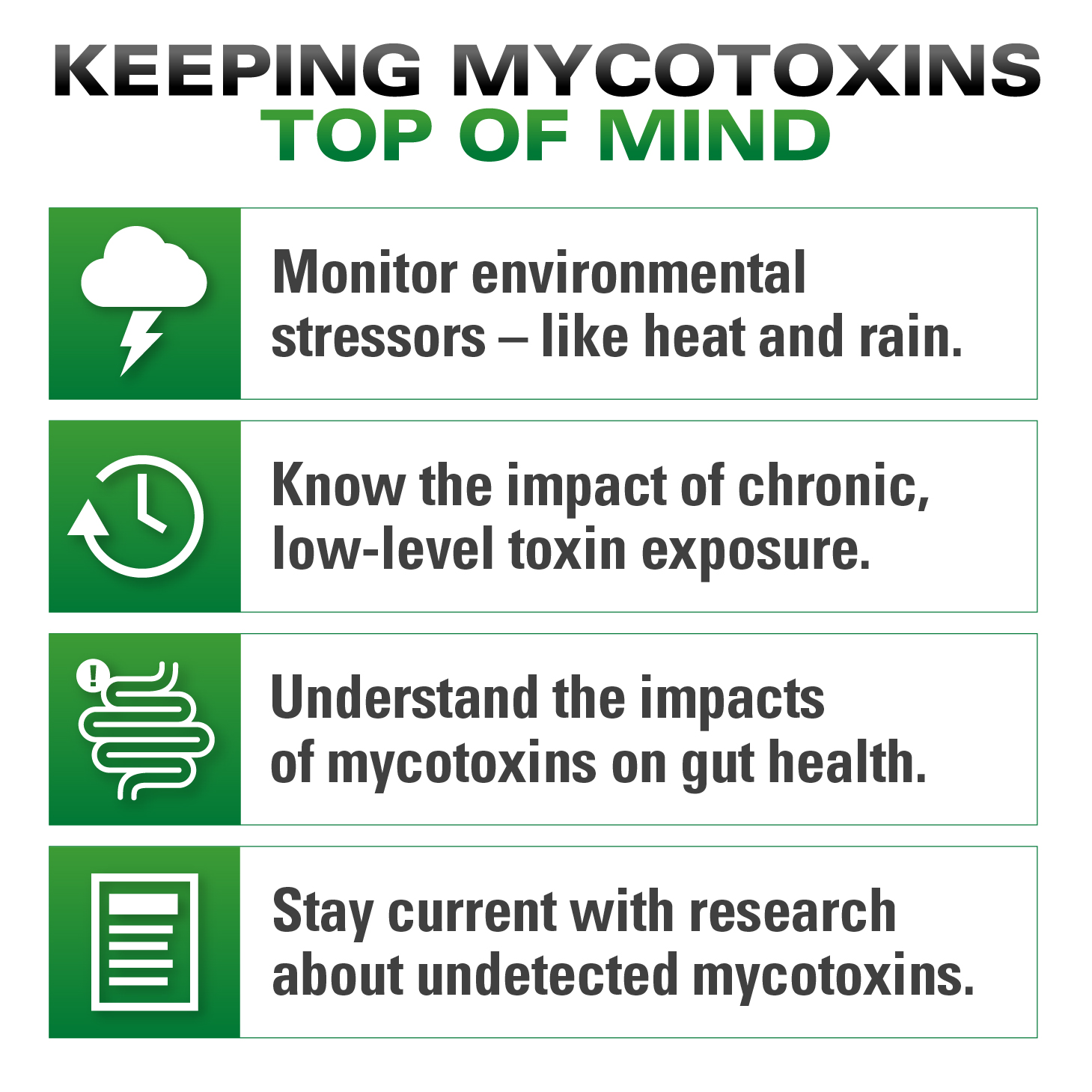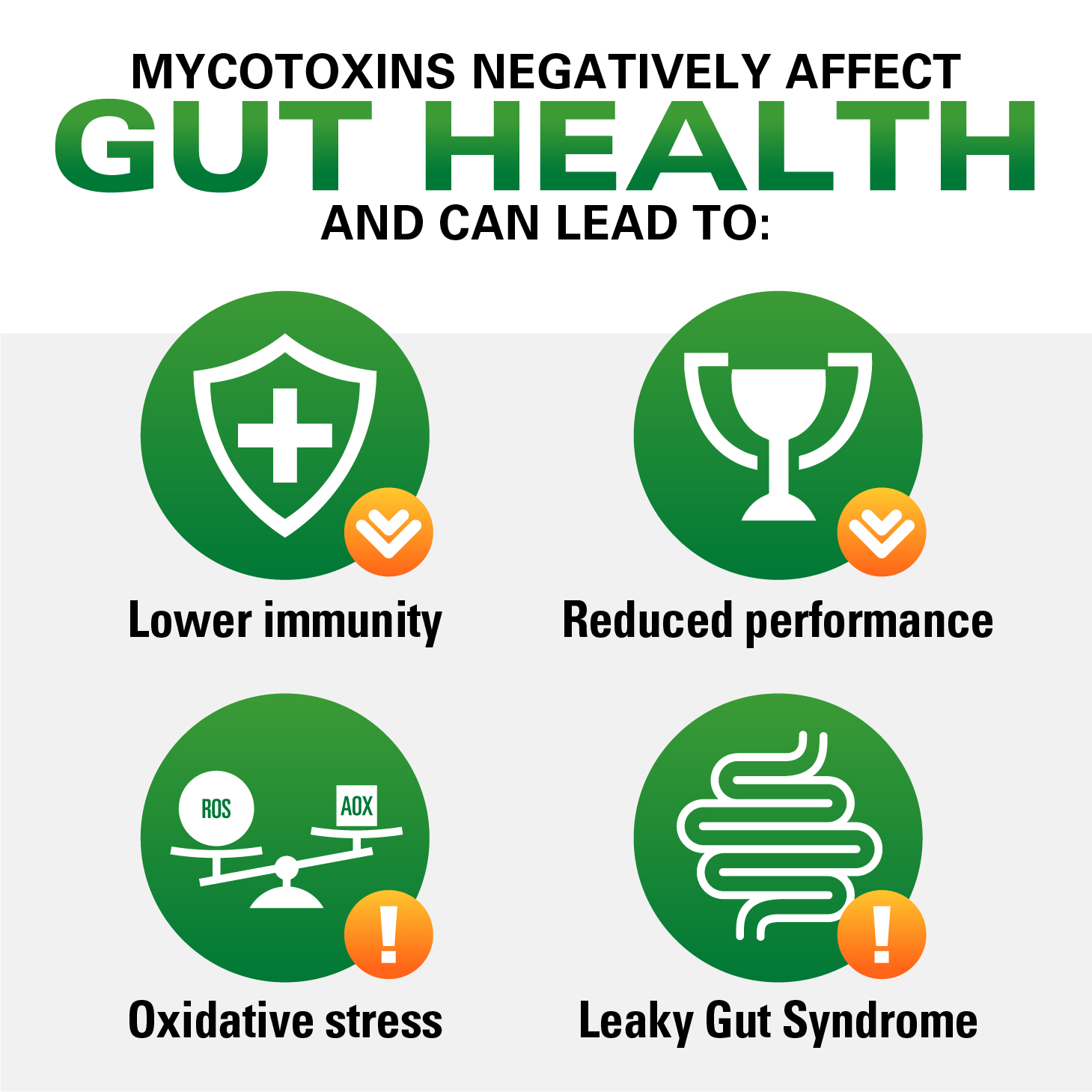Oxidative stress occurs when reactive oxygen species (ROS), like free radicals, exceed the antioxidant capacity of cells. Research has shown mycotoxins alter expression of multiple primary antioxidant enzymes, thereby resulting in accumulation of ROS, which can lead to localized inflammation, membrane lipid oxidation, altered cellular metabolism and eventually cell death.5 Mitigating mycotoxin-induced oxidative stress may be a potential strategy to limit toxic effects mycotoxins have on gut health.
4. Many mycotoxins go undetected
While reporting on mycotoxins has increased in recent years, the truth is of the 300+ mycotoxins known to contaminate animal feed, the majority go undetected today. Research indicates undetected toxins – like masked and emerging mycotoxins – are frequent co-contaminants in corn, wheat and barley that contain other common mycotoxins.6,7
Masked mycotoxins, like DON-3-glucoside and zearalenone-14-glucoside, are typically less toxic than their parent mycotoxin. However, the “unmasking” of these mycotoxins in the digestive tract, or by gut microbes, may lead to increased bioavailability of the free mycotoxin form.8,9 Moreover, little is known about the toxicity of emerging mycotoxins because they are neither routinely determined nor legislatively regulated.7 Research is still needed to better understand the risk these undetected toxins pose – alone or in combination – to livestock and poultry health.
Summary
Addressing the perennial mycotoxin problem would be simpler if mycotoxins were consistent over time. Unfortunately, the mycotoxin equation has multiple variables, many of which have limited research or remain undetected. For producers looking to fine-tune their mycotoxin management strategies this fall, an integrated, preventative approach is key. Managing grain quality through use of mold inhibitors, implementing a comprehensive mycotoxin testing program for incoming grains and inclusion of flow agents to neutralize dietary toxins can help ensure your herd or flock is best set up for success.
For more information about solutions to address the risk of mycotoxins in your operation please visit kemin.com/kallsil.
References
1CVM Annual Report on Mycotoxins in Animal Food Report for Fiscal Year 2016 (FY16). https://www.fda.gov/media/130526/download, accessed October 18, 2020.
2Hurburgh, Charles, et al. 2012. Aflatoxin in Corn. Iowa State University Extension and Outreach publication PM1800.
3Romero, A., et al. 2016. Mycotoxins modify the barrier function of Caco-2 cells through differential gene expression of specific claudin isoforms: Protective effect of illite mineral clay. Toxicology, 353-354: 21-33.
4Akbari, P., et al. 2017. The intestinal barrier as an emerging target in the toxicological assessment of mycotoxins. Arch. Toxicol., 91: 1007-1029.
5da Silva, E.O., et al. 2018. Mycotoxins and oxidative stress: where are we? World Mycotoxin Journal, 11: 113-133.
6Gruber-Dorninger, C. et al. (2017). Emerging mycotoxins: beyond traditionally determined food contaminants. J Agri Food Chem, 65: 7052-7070.
7Ekwomadu, T.I. et al. (2020). Variation of Fusarium free, masked, and emerging mycotoxin metabolites in maize form agriculture regions of south Africa, Toxins, 12(149); doi:10.3390/toxins12030149.
8Gratz, Silvia W. (2017). Do plant-bound masked mycotoxins contribute to toxicity? Toxins, 9(85); doi:10.3390/toxins9030085.
9Zhang, Z. et al. (2019). A systematic review of plant-conjugated masked mycotoxins: occurrence, toxicology, and metabolism. Critical review in food science and nutrition, doi:10.1080/10408398.2019.1578944.



